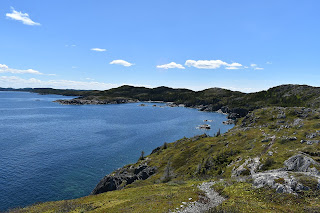Green Gardens
Bill hiked the Green Gardens Trail – a 7.5-mile hike to coastal cliffs topped with green meadows.
Bill hiked the Green Gardens Trail – a 7.5-mile hike to coastal cliffs topped with green meadows.
It’s
a long hike just to get to the ocean passing through barren landscape and
descending through forest. But then the trail brings you out on the ocean
cliffs.
Sheep
grazed on the grassy slopes.
Another
tourist asked Bill if he saw the “Teddy Bear.” Can you see the teddy bear shape
in this seastack?
Discovery Center
In the afternoon we went to the Discovery Center, which we found quite interesting – talking to rangers, looking at their displays & video, and taking in the view. Here’s a ranger explaining the pitcher plant using a quilted model.
In the afternoon we went to the Discovery Center, which we found quite interesting – talking to rangers, looking at their displays & video, and taking in the view. Here’s a ranger explaining the pitcher plant using a quilted model.
Lookout Trail
Afterward we took the Lookout Trail – a 3-mile hike with 1000 feet in elevation gain to a viewing platform. We went up, up, up, even seeing some snow along the trail.
Afterward we took the Lookout Trail – a 3-mile hike with 1000 feet in elevation gain to a viewing platform. We went up, up, up, even seeing some snow along the trail.
We
loved the panoramic view at the summit.
And
guess what was at the top? Red chairs.
The
clouds looked threatening, so we headed down – getting just enough rain to put
our cameras in plastic bags, but not enough to get us wet.



















































